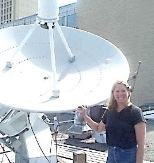CAMBRIDGE, Mass. -- Jacqueline N. Hewitt , professor of physics, is taking over the Center for Space Research at a time when our picture of the early history of the universe is changing dramatically.
"Results from different sources have been joined to create a more unified picture of the phases of the early universe," she said. "Many new doors may be opened by the latest research."
Hewitt, a radio astronomer, on Jan. 16 succeeded former director Claude R. Canizares, Bruno Rossi Professor of Experimental Physics at MIT and associate director of the Chandra X-Ray Observatory Center. Canizares was named associate provost of MIT in October 2001 after serving as head of CSR since 1990.
"Jackie Hewitt is a terrific scientist and will be a great director of the Center for Space Research," said Dean of Science Robert J. Silbey. "I am looking forward to working with her to continue the tradition of excellence in CSR."
SCIENCE MEETS TECHNOLOGY
Founded in 1965, the CSR is an interdepartmental center that supports research in space science and engineering, astronomy and astrophysics. CSR helps design, build and run instruments aboard NASA space vehicles. Its faculty are tied to the departments of Physics, Aeronautics and Astronautics and Earth, Atmospheric and Planetary Sciences.
The center's projects span X-ray, optical, radio and planetary astronomy, theoretical astrophysics, space plasma physics, gravitation and cosmology, theoretical geo/cosmo plasma physics, as well as the MIT Man-Vehicle Laboratory and the Space Nanotechnology Laboratory. Originally dependent on X-ray astronomy, the tools for space research have broadened in recent years to include ultraviolet and radio waves, data from increasingly powerful ground- and space-based optical and radio telescopes, and new possibilities such as gravity waves.
"There's marriage of science and technology here that's very exciting," Hewitt said. "The biggest asset of the CSR is the creativity of its faculty, research scientists and students. My goal is to make it as easy as possible for them to do what they want to do."
SPACE FOR SPACE RESEARCH
A recent renovation in building 37 has allowed astrophysicists to move from the physics department into the center. Shared open space between offices is allowing for increased collaboration and idea-sharing among faculty that Hewitt expects will bolster the existing "entrepreneurial" spirit that creates wide-ranging projects within the center.
Hewitt also hopes to see continuing projects in which researchers from outside the center seek CSR expertise. For decades, CSR researchers have helped design experiments for biologists and others that will take place in the harsh environment of outer space.
Hewitt, who has a bachelor's degree in economics from Bryn Mawr College and a Ph.D. in physics from MIT, joined the faculty at MIT in 1989. Her research interests are in the application of techniques of radio astronomy, interferometry, image processing and signal processing to problems in astrophysics. She is working on cosmology, gravitational lenses and surveys of transient astronomical radio emission.






